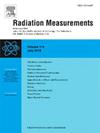确定超高剂量率电子束下可能的非线性闪烁体响应的来源
IF 2.2
3区 物理与天体物理
Q2 NUCLEAR SCIENCE & TECHNOLOGY
引用次数: 0
摘要
目的/目的先前对Exradin-W2 (Standard Imaging, Middleton, WI, USA)有机闪烁体在超高剂量率(UHDR)电子束下的研究显示,在高脉冲重复频率(PRF)和高脉冲剂量(DPP)下存在饱和迹象。本研究调查了在W2中观察到的饱和是由于静电计的限制而不是闪烁体本身的假设。材料/方法我们对1 × 3 mm W2探测器和1 × 2 mm BCF-12闪烁体在9 MeV电子束下的性能进行了一系列的测量。实验是用一台能够处理各种信号强度的光谱仪进行的。计算每个光谱的曲线下面积,并用于比较所有测量值。为了研究探测器对PRF变化的行为,我们将PRF值从10 Hz调整到120 Hz。通过改变每次采集的脉冲数,验证了与综合剂量的线性关系。此外,我们测试了探测器对DPP响应的线性度,将表面到源的距离改变到DPP为5.4 Gy。最后,将W2连接到长透明光纤延伸段,并与MAX SD静电计在与先前测量相同的光束参数下一起使用。结果BCF-12在所有脉冲宽度(PW)值下的信号灵敏度变化保持在6%以下,而对于W2,在60 Hz下,当脉冲宽度为2 μs时信号灵敏度下降最大(3%)。在测试的所有脉冲数中,探测器的响应都保持线性。两种探测器的响应都与综合剂量和DPP保持线性关系。透明纤维延伸的W2随着PRF的增加,信号减少。结论这些发现表明,先前观察到的非线性效应可能是由于静电计的局限性,而不是由于W2闪烁体的固有特性,静电计不是为UHDR光束设计的。本文章由计算机程序翻译,如有差异,请以英文原文为准。
Identifying the origins of possible nonlinear scintillator response under ultra-high dose rate electron beams
Purpose/objective
Previous studies of the Exradin-W2 (Standard Imaging, Middleton, WI, USA) organic scintillator under ultra-high dose rate (UHDR) electron beams, have shown signs of saturation at high pulse repetition frequencies (PRF) and high doses per pulse (DPP). This study investigated the hypothesis that the saturation observed in the W2 is due to limitations of the electrometer rather than the scintillator itself.
Material/methods
We conducted a series of measurements to assess the performance of a 1 × 3 mm W2 detector and a 1 × 2 mm BCF-12 scintillator under 9 MeV electron beams. The experiment was carried out using a spectrometer capable of handling a wide range of signal intensities. The area under the curve was computed for each spectrum and used to compare across all measurements. To investigate the behavior of the detector to variations in PRF, we adjusted the PRF values from 10 Hz to 120 Hz. The linearity to integrated dose was validated by varying the number of pulses per acquisition. Additionally, we tested the linearity of the detector's response to DPP by changing the surface-to-source distance up to a DPP of 5.4 Gy. Finally, the W2 was connected to a long clear fiber extension and was used with the MAX SD electrometer under the same beam parameters as the previous measurements.
Results
The signal sensitivity variation for BCF-12 remained under 6 % for all pulse width (PW) values tested across all PRFs, whereas for the W2, the maximum decrease in signal sensitivity (3 %) was for a PW of 2 μs at 60 Hz. The linearity of the detector's response was maintained across all pulse numbers tested. Both detectors' responses remained linear with respect to both integrated dose and DPP. The W2 with the clear fiber extension showed a decrease in signal as the PRF increased.
Conclusion
These findings suggest that the previously observed nonlinear effects are likely attributable to limitations of the electrometer, which was not designed for use with UHDR beams, rather than intrinsic properties of the W2 scintillator.
求助全文
通过发布文献求助,成功后即可免费获取论文全文。
去求助
来源期刊

Radiation Measurements
工程技术-核科学技术
CiteScore
4.10
自引率
20.00%
发文量
116
审稿时长
48 days
期刊介绍:
The journal seeks to publish papers that present advances in the following areas: spontaneous and stimulated luminescence (including scintillating materials, thermoluminescence, and optically stimulated luminescence); electron spin resonance of natural and synthetic materials; the physics, design and performance of radiation measurements (including computational modelling such as electronic transport simulations); the novel basic aspects of radiation measurement in medical physics. Studies of energy-transfer phenomena, track physics and microdosimetry are also of interest to the journal.
Applications relevant to the journal, particularly where they present novel detection techniques, novel analytical approaches or novel materials, include: personal dosimetry (including dosimetric quantities, active/electronic and passive monitoring techniques for photon, neutron and charged-particle exposures); environmental dosimetry (including methodological advances and predictive models related to radon, but generally excluding local survey results of radon where the main aim is to establish the radiation risk to populations); cosmic and high-energy radiation measurements (including dosimetry, space radiation effects, and single event upsets); dosimetry-based archaeological and Quaternary dating; dosimetry-based approaches to thermochronometry; accident and retrospective dosimetry (including activation detectors), and dosimetry and measurements related to medical applications.
 求助内容:
求助内容: 应助结果提醒方式:
应助结果提醒方式:


